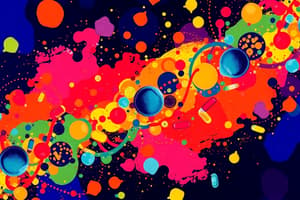Podcast
Questions and Answers
A drug that is highly lipophilic is being administered orally. Which of the following mechanisms of drug transport is most likely involved in its absorption from the gastrointestinal tract?
A drug that is highly lipophilic is being administered orally. Which of the following mechanisms of drug transport is most likely involved in its absorption from the gastrointestinal tract?
- Pinocytosis
- Simple diffusion (correct)
- Facilitated diffusion
- Active transport
A new drug is developed that is a large, hydrophilic molecule. Researchers want to target it specifically to cells within the liver. Which drug delivery mechanism would be most effective?
A new drug is developed that is a large, hydrophilic molecule. Researchers want to target it specifically to cells within the liver. Which drug delivery mechanism would be most effective?
- Filtration through aqueous pores
- Active transport using a broad-specificity transporter
- Receptor-mediated endocytosis (correct)
- Simple diffusion across the cell membrane
A drug is administered intravenously. Which of the following factors would most significantly affect its initial distribution into tissues?
A drug is administered intravenously. Which of the following factors would most significantly affect its initial distribution into tissues?
- The presence of specific drug transporters in the kidneys.
- The blood flow to various organs. (correct)
- The rate of active transport mechanisms in different tissues.
- The drug's affinity for plasma proteins.
A drug that is a weak acid with a pKa of 4.5 is administered orally. Where in the body will the drug be most readily absorbed?
A drug that is a weak acid with a pKa of 4.5 is administered orally. Where in the body will the drug be most readily absorbed?
Which of the following transport mechanisms requires energy input?
Which of the following transport mechanisms requires energy input?
A drug undergoes extensive first-pass metabolism. Which route of administration would likely result in the highest bioavailability for this drug?
A drug undergoes extensive first-pass metabolism. Which route of administration would likely result in the highest bioavailability for this drug?
A patient has significantly reduced liver function due to cirrhosis. How would this most likely affect the pharmacokinetics of a drug that is normally metabolized by the liver?
A patient has significantly reduced liver function due to cirrhosis. How would this most likely affect the pharmacokinetics of a drug that is normally metabolized by the liver?
A drug is known to bind extensively to plasma proteins. What effect would hypoalbuminemia (low albumin levels in the blood) have on the drug's distribution?
A drug is known to bind extensively to plasma proteins. What effect would hypoalbuminemia (low albumin levels in the blood) have on the drug's distribution?
A drug is transported across a cell membrane by a carrier protein, but in the process, it also transports another molecule in the opposite direction. This type of transport is known as:
A drug is transported across a cell membrane by a carrier protein, but in the process, it also transports another molecule in the opposite direction. This type of transport is known as:
Which of the following best describes the process of filtration in drug transport?
Which of the following best describes the process of filtration in drug transport?
Flashcards
Pharmacology
Pharmacology
The study of drugs and their effects on the body.
Pharmacokinetics (ADME)
Pharmacokinetics (ADME)
What the body does to the drug involving absorption, distribution, metabolism, and excretion.
Pharmacodynamics
Pharmacodynamics
What the drug does to the body; the effects of the drug and their mechanisms of action.
Drug Absorption
Drug Absorption
Signup and view all the flashcards
Drug Distribution
Drug Distribution
Signup and view all the flashcards
Drug Metabolism
Drug Metabolism
Signup and view all the flashcards
Drug Excretion
Drug Excretion
Signup and view all the flashcards
Diffusion
Diffusion
Signup and view all the flashcards
Facilitated Diffusion
Facilitated Diffusion
Signup and view all the flashcards
Active Transport
Active Transport
Signup and view all the flashcards
Study Notes
Pharmacology
- It is the study of the interaction of chemical agents with biological systems
- These chemical agents can be endogenous or xenobiotic substances
Endogenous Substances
- These are synthesized within the body
- Examples include hormones and neurotransmitters
Xenobiotic Substances
- These are synthesized outside the body
- Examples include drugs and toxins
Pharmacology Divided
- Pharmacokinetics describes what the body does to the drug.
- Pharmacodynamics describes what the drug does to the body.
Four Primary Aspects of Pharmacokinetics (ADME)
- Absorption refers to the movement of a drug into the bloodstream.
- Distribution involves the spread of the drug to various body sites.
- Metabolism is the process by which the drug is chemically altered.
- Excretion is the removal of the drug from the body.
Biological Transport
- Drugs must cross biological membranes to reach their targets within the body
- Drugs need to be transported to be absorbed, distributed, metabolized, and excreted
Cell Membrane
- It is primarily composed of a lipid matrix and proteins.
- Lipids are arranged in a bilayer, providing a barrier to water-soluble substances.
- Proteins act as structural components, receptors, ion channels, and enzymes.
Types of Drug Transport
- Passive diffusion
- Facilitated diffusion
- Active transport
- Pinocytosis
Passive Diffusion
- It is the movement of drugs from an area of high concentration to an area of low concentration
- It does not require energy (ATP)
- It follows Fick's Law of Diffusion, where the rate of diffusion is proportional to the concentration gradient, surface area, and permeability of the membrane
Key Considerations for Passive Diffusion
- Lipid solubility: Lipid-soluble drugs diffuse more easily across cell membranes.
- Drug size: Smaller molecules tend to diffuse more readily than larger ones.
- Ionization: Non-ionized drugs are more lipid-soluble and diffuse better than ionized drugs.
Filtration
- It involves the movement of drugs through aqueous pores in the membrane.
- It depends on the size of the drug molecule.
- It is significant for very small drugs (e.g., water, urea, and some ions).
Carrier-Mediated Transport
- It involves specific carrier proteins that bind to drugs and facilitate their movement across membranes.
- It includes two types: facilitated diffusion and active transport.
Facilitated Diffusion
- It requires a carrier protein but does not require energy.
- It moves drugs down their concentration gradient.
- It can be saturated and may be inhibited by other drugs that compete for the same carrier.
Active Transport
- It requires a carrier protein and energy (ATP) to move drugs against their concentration gradient.
- It is saturable and can be inhibited by other drugs.
- It includes primary active transport (uses ATP directly) and secondary active transport (uses the electrochemical gradient of another molecule).
Secondary Active Transport
- It uses the electrochemical gradient of one ion (typically Na+) to transport another molecule
Two Types of Secondary Active Transport
- Symport (Co-transport): Both the ion and the drug move in the same direction across the membrane.
- Antiport (Counter-transport): The ion and the drug move in opposite directions across the membrane.
Pinocytosis
- It involves the engulfment of fluids or small particles by the cell membrane.
- The cell membrane invaginates, forming a vesicle that encloses the substance, and then the vesicle is internalized into the cell.
- It is important for the transport of very large molecules (e.g., proteins).
Studying That Suits You
Use AI to generate personalized quizzes and flashcards to suit your learning preferences.




